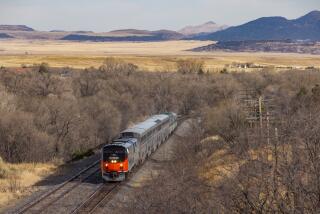âCadillac of steamâ to ride the rails again
About 25 years ago, a group of Southern California train enthusiasts made either the best or the worst investment of their lives, depending on how you look at it.
For the grand sum of $1, they bought the Santa Fe 3751, a 430-ton locomotive that had once played a seminal role in introducing high-capacity, high-speed passenger rail service to the West. Then they set out to get the thing working again, which wound up taking five years, $1.3 million, including cash outlay and in-kind contributions, and the work of nearly 400 volunteers.
Now, the 3751 is about to make a triumphant return to the public rails, the latest turn in what has been both a glorious and tortuous history.
On May 1 and 2, the locomotive will ferry as many as 500 people between Los Angeles and San Diego, pulling 10 Amtrak cars.
The train will depart from Los Angeles the morning of May 1 and return from San Diego the next day. Arrangements for single-day, down-and-back travel are also available. Proceeds from the trip will be used to cover the $50,000 yearly cost of maintaining and housing the locomotive. Information can be found at goldenstaterails.com.
The Santa Fe railroad ordered the 3751 in 1927; with an unusual wheel configuration known as a â4-8-4,â it was the first of its kind. It operated until 1955, primarily between California and the Midwest, but also in New Mexico and Colorado.
âIt started a whole new class of high-speed passenger engines,â said Fred Hill, a director of the nonprofit San Bernardino Railroad Historical Society, which serves as the locomotiveâs caretaker. âThis was the Cadillac of steam in its heyday.â
The society (whose name is misleading because it has long been based in Los Angeles) bought the weather-beaten locomotive from the city of San Bernardino in 1986.
In the 1990s, after the restoration effort, the train enthusiasts took the locomotive on a handful of trips. But the engine was stalled again after Santa Fe merged with Burlington Northern Railroad in 1996. The new corporate ownership felt no compulsion to accommodate an outdated engine from a defunct company, Hill said.
âWe became a historical nuisance,â he said.
In recent years, the train enthusiasts have labored to ride again. The 3751 has been permitted a few times to pull passenger cars to San Diego, the Grand Canyon and elsewhere.
âWe really had to prove ourselves,â Hill said. âWeâre pretty proud of that.â
Recent trips, however, were limited largely to private passenger cars. Now, the enthusiasts are preparing for the largest public offering of tickets in the locomotiveâs new life.
Recently, roughly two dozen volunteers began preparing for the trip at a rail yard east of downtown Los Angeles.
Getting the locomotive running is an immensely complex task. For instance, the group must boil 5,000 gallons of water to begin running the locomotive, but must heat it slowly in the boiler. Otherwise, the stress can damage the trainâs metal components.
Sitting in the engineerâs compartment, Bob Kittel, another board member and a founding volunteer, said the group had added a sprinkling of modern concessions, including a new radio and an electronic device that can activate the old air brakes in a hurry if needed. But the train runs just as it always has, harnessing steam created by burning fuel at temperatures reaching 2,400 degrees in the firebox at a rate of 12 gallons per mile.
Kittel will serve as the âfiremanâ for the trip to San Diego, maneuvering a series of valves that control steam to match the actions of the engineer, who will sit on the opposite side of the cab controlling the throttle, brakes and train handling. Kittel looked relaxed in the cab, though he was surrounded by a dizzying nest of valves, gauges, pipes and pulleys, all affixed with old-time-y labels: Atomizer, Blowback, Dynamo.
âAfter a while, itâs like living in your house â you know where all the light switches are and how to walk around in the dark,â he said. âThis is no different.â
More to Read
Sign up for The Wild
Weâll help you find the best places to hike, bike and run, as well as the perfect silent spots for meditation and yoga.
You may occasionally receive promotional content from the Los Angeles Times.







